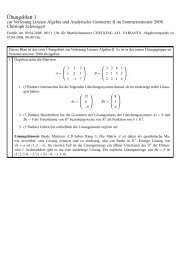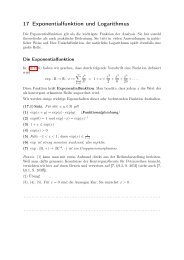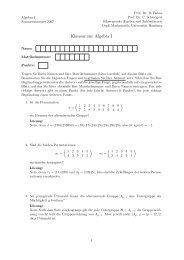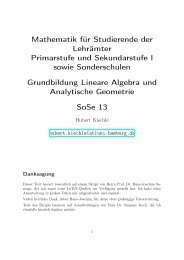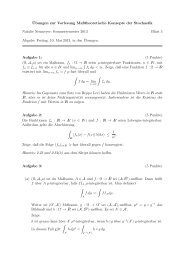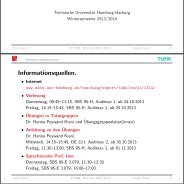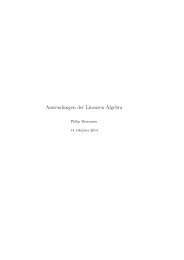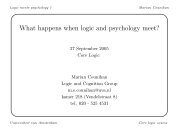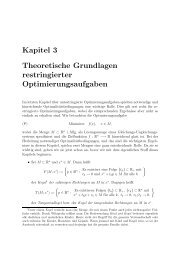pdf file
pdf file
pdf file
You also want an ePaper? Increase the reach of your titles
YUMPU automatically turns print PDFs into web optimized ePapers that Google loves.
S = S =<br />
and in Sweedler notation<br />
x (1) ∙ S(x (2) ) = ɛ(x) ∙ 1 = S(x (1) ) ∙ x (2) .<br />
2. If an antipode exists, it is, as a two-sided inverse for an associative product, uniquely<br />
determined:<br />
S = S ∗ (ηɛ) = S ∗ (id H ∗ S ′ ) = (S ∗ id H ) ∗ S ′<br />
= ηɛ ∗ S ′ = S ′ .<br />
3. With H = (A, μ, η, Δ, ɛ, S) a finite-dimensional Hopf algebra, its dual H ∗ =<br />
(A ∗ , Δ ∗ , ɛ ∗ , μ ∗ , η ∗ , S ∗ ) is a Hopf algebra as well.<br />
4. We will see later that any morphism f : H → K of bialgebras between Hopf algebras<br />
respects the antipode, f(S H h) = S K f(h) for all h ∈ H. It is thus a morphism of Hopf<br />
algebras.<br />
5. A subspace I ⊂ H of a Hopf algebra H is a Hopf ideal, if it is a biideal and if S(I) ⊂ I.<br />
In this case, H/I with the structure induced from H is a Hopf algebra.<br />
Examples 2.5.4.<br />
1. If G is a group, the group algebra K[G] is a Hopf algebra with antipode<br />
Indeed, we have for g ∈ G:<br />
S(g) = g −1 for all g ∈ G .<br />
μ ◦ (S ⊗ id) ◦ Δ(g) = g ∙ g −1 = ɛ(g)1 .<br />
2. The universal enveloping algebra U(g) of a Lie algebra g is a Hopf algebra with antipode<br />
Indeed, we have for x ∈ g:<br />
S(x) = −x for all x ∈ g .<br />
μ ◦ (S ⊗ id) ◦ Δ(x) = μ(−x ⊗ 1 + 1 ⊗ x) = −x + x = 0 = 1ɛ(x) .<br />
In particular, the symmetric algebra over a vector space V is a Hopf algebra, since it is the<br />
universal enveloping algebra of the abelian Lie algebra on the vector space V . Similarly,<br />
the tensor algebra T V over a vector space V is a Hopf algebra, since it can be considered<br />
as the enveloping algebra of the free Lie algebra on V .<br />
If (A, μ A ) and (B, μ B ) are algebras, a map f : A → B is called an antialgebra map, if it<br />
is a map of unital algebras f : A → B opp , i.e. if f(a ∙ a ′ ) = f(a ′ ) ∙ f(a) for all a, a ′ ∈ A and<br />
f(1 A ) = 1 B .<br />
Similarly, if (C, Δ C ) and (D, Δ D ) are coalgebras, a map g : C → D is called an<br />
anticoalgebra map, if it is a counital coalgebra map g : C → C copp , i.e. if ɛ D ◦ g = ɛ C and<br />
g(c) (2) ⊗ g(c) (1) = g(c (1) ) ⊗ g(c (2) ) .<br />
32






